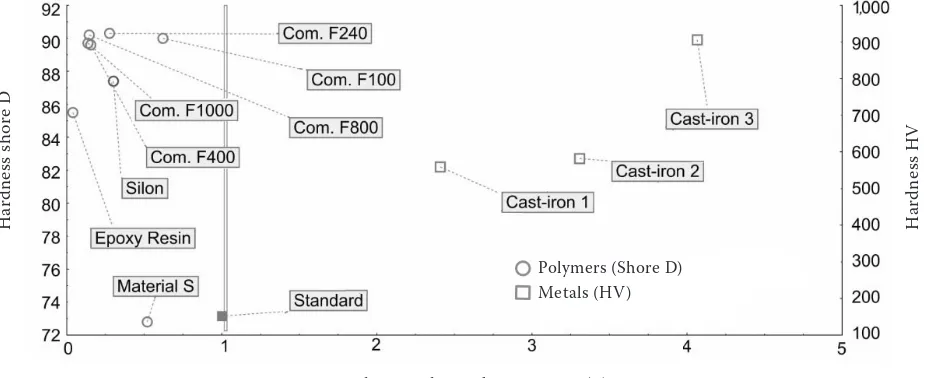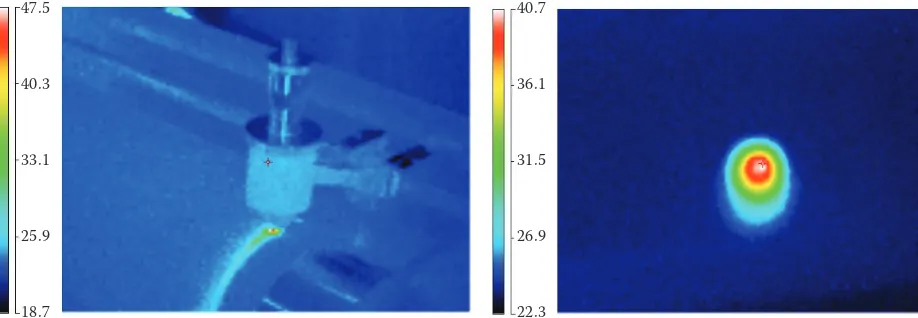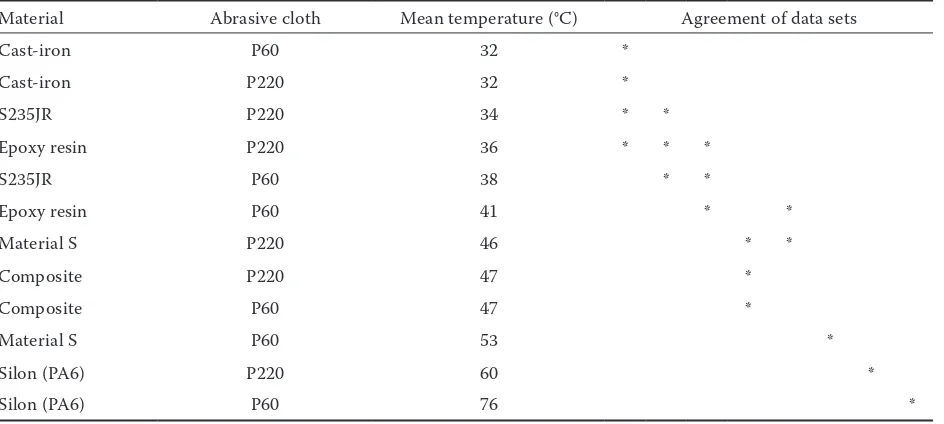Influence of two-body abrasion and heat intensity
on metal and non-metal materials used in agriculture
P. Valášek, J. Kejval, M. Müller, J. Cieslar
Department of Material Science and Manufacturing Technology, Faculty of Engineering,
Czech University of Life Sciences Prague, Prague, Czech Republic
Abstract
Valášek P., Kejval J., Müller M., Cieslar J. (2015): Influence of two-body abrasion and heat intensity on metal and non-metal materials used in agriculture. Res. Agr. Eng., 61: 40–46.
In the agro-complex, as well as in other sectors, the use of polymeric materials is one possible way forward in the innovation and development of machines and their parts. However, machine products place high demands on the materials from which they are made. Polymeric materials are currently able to compete in certain areas where metallic material would traditionally be used; however, one of their limiting characteristic is their ability to withstand elevated temperatures. This paper describes the hardness of polymeric materials when influenced by heat, generated during the double body abrasion. The paper also describes the abrasive wear of both polymers and polymeric composite systems, as well as cast iron, used in agricultural production. Heat intensity during the two-body abrasion results in a 28% fall of the composite systems hardness, to 18% fall of the Polyamid 6 hardness and to 13% fall of the Murtfeld hardness.
Keywords: abrasive wear; composite systems, epoxy resin, polymers; temperature
In recent years, industry has seen an increase in the production of plastic products in an attempt to replace the conventionally used metallic materials. One of these sectors is agriculture. The use of poly-mers have considerable advantages to the agricul-tural industry, they are easy to mould, resistant to corrosion and environmental deterioration. They have an ability to temper vibrations, low density and are cost-effective. In a specific application of various materials, particularly polymeric materials, it is necessary to consider the considerable depend-ence on temperature (Parry, Tabor 1973).
Abrasive wear occurs when a specimen comes into contact with the abrasive material. The motion of the specimen on the abrasive material creates friction and
part of this mechanical energy is converted into heat. The effects of heat at varying intensity can affect the characteristics and composition of many materials.
Polymeric materials predominantly transfer heat through the vibratory motion of atoms while me-tallic materials transfer heat through the kinetic energy of electrons. It is for this reason that poly-meric materials are usually of lower thermal con-ductivity, increasing temperatures create a down-ward effect on the yield strength of thermoplastic materials. This is evident, although not so obvious, in metallic materials. The prevailing characteristic of chemical bonds in polymeric materials results in their higher thermal expansion compared with me-tallic materials (Vojtěch 2010).
According to Müller et al. (2011) depositing of the composites strongly associated with the base material belongs among non-traditional ways of creating new functional layers (especially in ag-riculture). As a matrix, reactoplastics are mostly used – an epoxy resin filled with microparticles or microparticles on a base of waste corundum or garnet (Valášek, Müller 2012a). Satapathy and Bijwe (2002) describe the increased resistance to abrasive wear of thermoplastics filled with mi-croparticles of corundum. Adding mimi-croparticles also affects the thermal properties of the primary material. Mohan et al. (2012) in their experiments used particles of graphite and silicon carbide as a filler and their presence led to an increase of the two-body and three-body abrasion resistance. Polymeric materials can be used in agriculture for the construction of floor coverings in forage ar-eas where, in addition to excellent durability and resistance to wear and tear, they excel in their re-sistance to environmental deterioration garnet (Valášek, Müller 2012b). Maatta et al. (2009) mention the use of polyurethane, acrylic, polyester or epoxy coatings. Thermoplastics such as poly-ethylene or polyamide can be used in the design of screw conveyors, sliding segments or bearings. Parry and Tabor (1973) describe the changes in the properties of polypropylene and polyethylene in response to changes in pressure and temperature unlike Müller and Valášek (2012) who compare volume loss of the thermoplastics and composites
with the thermosetting matrix, however without regarding the influence of temperature. Similar comparisons of the tribological properties of poly-amid 6 and polyethylene are described by Palabi-lyik and Bahadarus (2000, 2002).
The aim of the experiment was to evaluate the effect of heat generated in the two-body abrasion hardness of polymeric materials. The paper de-scribes two-body abrasion of both polymeric and metallic materials used for the renovation and pro-duction of machine parts. It focuses on the heat generated during the abrasion, which can affect the characteristics of the polymer materials and polymeric composite systems. A quantification of arisen heat together with a description of chang-es caused to the material qualitichang-es – the polymer hardness – can lead to the correct identification of the application areas. For example in the area of ag-ricultural production, the heat arises by the friction at the contact of functional areas with the soil (soil processing) or in the area of processing materials (conveyers, chutes).
MATERIAL AND METHODS
Polymeric materials, from the sphere of the ther-moplastics, were represented by the polyethylene – Material S (Murtfeld) and Polyamid 6 (Silon – PA6), reactoplastics by the epoxy resin (Eco Epoxy 324/1200) which was also filled with the corundum
Relative volume abrasive wear (–)
H
ar
dne
ss H
V
H
ar
dne
ss s
hor
[image:2.595.68.532.522.711.2]e D
Fig. 1 Relationship between hardness and relative volume of abrasive wear (P220) Com. – composite
microparticles of mean specific grain size 137.5 μm, 44.5 μm, 17.3 μm and 6.5 μm. The inclusion of the corundum microparticles into the epoxy resin was carried out by a mechanical mixing when the test-ing samples were cast into rubber moulds. Testtest-ing samples were prepared with 30 volume percents of fillers.
Metallic materials were represented by three hard-faced overlaid white cast irons. The white cast iron is characterized by the occurrence of carbon in the form of cementite, allowing it to exhibit greater hardness and wear resistance. However, these cast
iron machines are at the same time very heavy (Novák, Doležal 2012). Typical machines of this type used in agriculture are jaw crushers and ball mills. The carbon steel S235JR served as the com-paring standard.
Setting the wear resistance was carried out by a modification of the test according to ČSN 62 1466:1993. The testing machine with the abrasive cloth consists of the rotating drum on which the abrasive cloth is affixed by means of a bilateral ad-hesive tape. The testing specimen is secured in the pulling head and during the test, it is shifted by means of a mowing screw along the abrasive cloth from the left edge of the drum to the right one. The testing specimen is in contact with the abra-sive cloth and it covers the distance of 60 m. Dur-ing one drum turn of 360° the testDur-ing specimen left above the abrasive cloth surface is provoked. Con-sequent impact of the testing specimen simulates the concussion. The pressure force is 10 N. The size of the testing specimens was 10.0 ± 0.1 mm and their height was 20.0 ± 0.1 mm. The mass losses were measured on analytic scales weighing on 0.1 mg. The volume losses were calculated from mass and density of the composite systems. The Shore D hardness of polymeric materials was measured ac-cording to the standard ČSN EN ISO 868, the cast irons hardness was set according to Vickers (HV 30, 294 N).
[image:3.595.83.528.93.292.2]The testing samples temperature was measured by means of a thermocamera (Flir i7type) and it was evaluated by relevant software (Flir Tools) both
Fig. 2. Relationship between hardness and relative volume of abrasive wear (P60) Com. – composite
Table 1. Density of materials
Material Density (g/cm3)
Material “S” 0.93
Silon (PA6) 1.16
Epoxy resin 1.15
Composite F100 2.01
Composite F240 2.01
Composite F400 2.01
Composite F800 2.01
Composite F1000 2.01
Standard S235JR 7.8
Cast-iron (1) 7.7
Cast-iron (2) 7.7
Cast-iron (3) 7.7
H
ar
dne
ss H
V
H
ar
dne
ss s
hor
e D
Relative volume abrasive wear (–)
[image:3.595.62.291.531.755.2]from Flir systems, Inc., Meer, Belgium. The labora-tory environment temperature reached 23.7 ± 1°C during the abrasive tests.
RESULTS
Fig. 1 and 2 show the comparison of volume loss of the cast iron and polymeric materials with the S235JR steel in the form of the relative abrasive wear. The S235JR steel has the value 1, smaller vol-ume losses are situated on the left from this value, higher volume losses are on the right. From the graphical presentation it is visible that experimen-tally evaluated overlaid materials showed lower volume loss than the S235JR steel (the comparing standard) both on the abrasive cloth P60 and on the abrasive cloth P220. For the abrasive cloth P60, this steel showed the volume loss 0.0248 cm3, for the cloth P220 it was 0.0153 cm3. From the results,
the clear fall of the composite systems volume loss compared with the resin without the filler is vis-ible. In comparison with S235JR steel (the com-paring standard, ψ = 1) the composite systems are significantly less wear resistant. On evaluating the abrasive wear and the hardness, the variation coef-ficients did not exceed the 5% limit.
The volume losses were set on the basis of mate-rial density which is presented in Table 1. During the testing of the samples, heat creation and its intensity is important in the sphere of the polymeric materials. Heat intensity was evaluated by means of the ther-mocamera on which test material temperatures were recorded. Fig. 3 shows the temperature increasing during the test (on the left) and a contact surface of the testing samples after carrying out the test (on the right – the composite system with the filler F1000).
[image:4.595.66.525.96.255.2]Fig. 4 shows the graphical presentation of the temperatures measured according to single mate-rials types on the abrasive clothes P60 and P220
[image:4.595.66.355.561.760.2]Fig. 3. Temperature measurement (°C) during the test of abrasive wear
Fig. 4. Influence of material type on aris-ing heat
47.5
40.3
33.1
25.9
18.7
40.7
36.1
31.5
26.9
22.3
Abrasive cloth P60: F(5;33) = 214,072; P = 0.0000 Abrasive cloth P220: F(5;33) = 193,3888; P = 0.0000
Abrasive cloth P60 Abrasive cloth P220
Tem
pera
tur
e (°C
)
80
70
60
50
40
30
Composite
created by means of ANOVA of the Statistica pro-gramme (Statistica 12; StatSoft CR, Prague, Czech Republic) by the lowest squares method (α = 0.95). The comparison of the statistical agreement is pre-sented by means of the Tukey’s HSD test (Table 2). Reducing curves of the hardness depending on the temperature in the interval 20–100°C were set
for the polymeric materials in relation to the meas-ured values of temperature (Fig. 5).
A correlation field of the hardness values can be fit by functions for each polymeric material. Their functional equations are stated in Table 3. Epoxy resin began to display signs of cracking at tempera-tures of 90°C. Similar behaviour was also displayed by the composite systems based on the epoxy resin, however the inclusion of the corundum particles slowed down the hardness values fall with the in-creasing temperature. For the metallic materials, a presumption was reasoned that in the evaluated temperature interval (20–100°C) the hardness was not significantly influenced.
DISCUSSION
[image:5.595.64.536.116.328.2]The filler presence in the polymeric matrix signif-icantly increased the ability of the reactoplastics to resist the two-body abrasion in comparison to the
Table 2. Tukey’s HSD test
Material Abrasive cloth Mean temperature (°C) Agreement of data sets
Cast-iron P60 32 *
Cast-iron P220 32 *
S235JR P220 34 * *
Epoxy resin P220 36 * * *
S235JR P60 38 * *
Epoxy resin P60 41 * *
Material S P220 46 * *
Composite P220 47 *
Composite P60 47 *
Material S P60 53 *
Silon (PA6) P220 60 *
Silon (PA6) P60 76 *
*indicates a homogeneous group in column, α = 0.05
Fig. 5. Reducing curves of hardness depending on tem-perature
0
20 40 60 80 100
0 20 40 60 80 100 120
Har
dne
ss Shor
e D
Temperature (°C) Composite
[image:5.595.63.532.383.473.2]Epoxy resin Silon (PA6) Material S
Table 3. Functional equations of reducing curves
Material Functional equation R2 Temperature decrease (20–100°C)/corresponding hardness for
temperatures reached by abrasion (shore D) Epoxy resin y = –0.6592x + 86 0.85 70%/58.9
Composite y = –0.4788x + 90 0.78 66%/65.1
Material S y = –0.17x + 73 0.67 36%/63.1
[image:5.595.66.289.592.728.2]resin without the filler. Results show volume losses of 48% on the abrasive cloth P60 and of 84% on the abrasive cloth P220 (the composite with the filler F100). At the same time, the influence of the filler particle size on the abrasive wear resistance was proved. However, the composite materials were at least 5× less wear resistant in comparison to stand-ard steel S235JR. The overlaid systems showed the volume loss of 73% smaller than steel S235JR. In the sphere of the composite systems the results draw the same conclusions as Jia and Ling (2005) who set the interval 40.5–161 μm at the primary corun-dum, which has the influence on the high two-body abrasion resistance. Satapathy and Bijwe (2002) set this interval as 40–100 μm at the phenolic res-ins filled with the corundum particles. By measur-ing the temperature durmeasur-ing the abrasive wear test, it was found out that PA6, Material S and compos-ite systems were the most burdened with increased temperatures in the contact place of the testing samples with the abrasive cloth. Satapathy and Bijwe (2002) in their study of the composite parti-cle systems confirmed a parti-clear correlation between the hardness and the abrasive wear. From this rea-son the recorded fall of the Shore D hardness in the observed interval of temperatures (20–100°C) has to be taken into regard at applications requiring in-creased wear resistance of the polymers.
CONCLUSIONS
The experiment confirmed that the described mechanical properties allow the use of the afore-mentioned thermoplastics and filled reactoplastics in the sphere of the agricultural production. The polymeric materials do not reach such wear resist-ance as the reviewed overlays, but their price, low weight and workability are regarded as the advan-tages. Limiting can be the tendency to change the mechanical qualities already at tiny temperature increase as it follows from the experiment.
– At the epoxy resin the heat created during the two-body abrasion would lead, according to the created functional equation of the dependence of the hardness on the temperature, to 32% fall of the Shore D hardness, at the composites the fall would be 28%, at the Material S 14% and at the PA6 17%.
– The highest abrasive wear resistance of the pol-ymeric materials showed the composite F100
(0.04 cm3, ψ = 0.62) for the abrasive cloth P220 and the Material S (0.07 cm3, ψ = 0.22) for the cloth P60.
– The potential application area for the thermo-plastics evaluated in the experiment can be screw conveyers or chutes.
– Filled reactoplastics can be used for renovation of the agricultural machines parts (functional ar-eas) or they can be applied in the sphere of the adhesive bonding and joining materials, howev-er, only in places where their mechanical quali-ties are sufficient.
– The overlaid materials (cast irons) can be used for renovation of functional areas on which high mechanical qualities are required (e.g. wear re-sistance).
References
Maatta J., Hellstedtb M., Kuismaa R., Kymalainen H.R., Mahl-berg R., SjoMahl-berg A.M. (2009): Effects of chemical and me-chanical wearing on the cleanability and surface properties of traditional and new surface materials in cattle barns – a laboratory study. Biosystems Engineering, 103: 464–473. Mohan N., Natarajan S., Kumaresh Babu S.P. (2012): The role
of synthetic and natural fillers on three-body abrasive wear behaviour of glass fabric-epoxy hybrid composites. Journal of Applied Polymer Science, 124: 484–494.
Müller M., Valášek P. (2012): Abrasive wear effect on poly-ethylene, polyamide 6 and polymeric particle composites. Manufacturing Technology, 12: 55–59.
Müller M., Valášek P., Novák P., Hrabě P., Paško J. (2011): Ap-likace návarů a kompozitů v oblasti technologie pěstování a sklizně cukrové řepy. Listy cukrovarnické a řepařské, 9: 304–307.
Novák M., Doležal R. (2012): G-Ratio in hardened steel grinding with different coolant. Manufacturing Technol-ogy, 13: 192–197.
Palabilyik M., Bahadarus S. (2002): Tribological studies of polyamide 6 and high-density polyethylene blends filled with PTFE and copper oxide reinforced with short glass fibers. Wear, 253: 369–376.
Palabilyik M., Bahadarus S. (2000): Mechanical and tribological properties of polyamide 6 and hight density polyethylene po-lyblends with and without compatibilizer. Wear, 246: 149–158. Parry E.J., Tabor D. (1973): Effect of hydrostatic pressure and
Valášek P., Müller M. (2012a): Influence of bonded abrasive particles size on wear of polymeric particle composites based on waste. Manufacturing Technology, 13: 268–272. Valášek P., Müller M. (2012b): Polymeric particle composites
with filler saturated matrix. Manufacturing Technology, 13: 272–276.
Vojtěch D. (2010): Materials and their Limit States. Prague, VŠCHT.
Jia X., Ling X.O. (2005): Influence of Al2O3 reinforcement on the abrasive wear characteristic of Al2O3/PA1010 composite coatings. Wear, 258: 1342–1347.
Received for publication February 2, 2013 Accepted after corrections October 14, 2014
Corresponding author:
Ing. Petr Valášek, Ph.D., Czech University of Life Sciences Prague, Faculty of Engineering, Department of Material Science and Manufacturing Technology, Kamýcká 129,
165 21 Prague 6-Suchdol, Czech Republic



